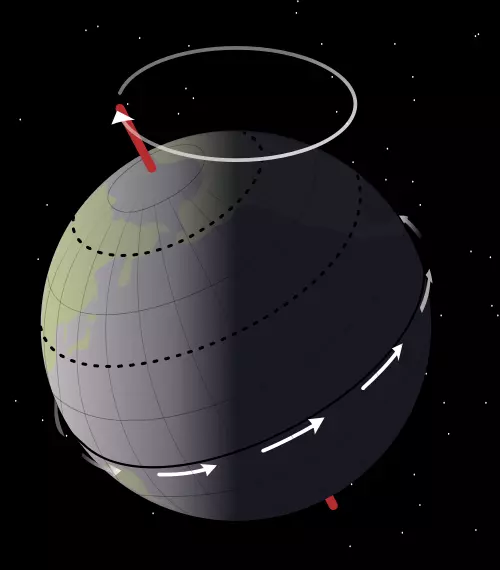 As the Earth orbits the sun, the sun appears to move against the background stars (red line). The constellations (green) through which the sun passes define the zodiac. Image via Tau’olunga/ Wikipedia.
As the Earth orbits the sun, the sun appears to move against the background stars (red line). The constellations (green) through which the sun passes define the zodiac. Image via Tau’olunga/ Wikipedia.
The zodiac, with its 12 signs listed in a horoscope, is a concept closely tied to the movement of the Earth through the sky. The signs are derived from the constellations that mark the path the sun appears to take throughout the year. While some may assume that the dates in a horoscope align with when the sun passes through each constellation, the reality is more complex. Astrology and astronomy are distinct systems, and a closer examination of Earth's motion reveals the intricacy of the zodiac.
The Sun's Motion through the Constellations
As the Earth orbits the sun, the sun appears to pass in front of different constellations. Similar to how the moon's position changes in the sky each night, the sun's location relative to distant stars drifts slightly eastward from day to day. However, it's important to note that this motion is merely an illusion caused by Earth's own movement around our star.
Over the course of a year, the sun appears in front of different constellations. For example, one month the sun seems to be in Gemini, while the following month it appears in Cancer. The dates mentioned in horoscopes indicate when the sun appears in a specific astrological sign. However, your astrological sign doesn't necessarily correspond to the constellation the sun was in on the day you were born. It's not as straightforward as it seems!

Why the Zodiac Constellations Don't Always Align with Astrological Signs
To understand why constellations no longer align perfectly with their corresponding signs, we must delve into how the Earth moves and how we measure time.
Defining time, especially when using the sun and stars as references, presents challenges. Our calendar is intricately tied to the seasons. For example, June 21 marks the approximate date of the summer solstice in the northern hemisphere and the winter solstice in the southern hemisphere. It's the day the sun appears at its most northerly point in the sky, with the North Pole tilting most towards the sun.
However, the North Pole doesn't always point in the same direction relative to the background stars. The Earth spins and wobbles, causing the North Pole to trace a circle on the celestial sphere. This wobble is gradual and takes around 26,000 years to complete. As the years pass, the cumulative effect leads to changes in the Earth's axis's direction.
Consequently, the location along our orbit where solstices occur also shifts by a minuscule amount. In fact, the solstice now happens about 20 minutes earlier than one complete trip in front of the background stars!
Our Drifting Calendars
Our calendar, as well as the signs in astrology, relies on the solstices and equinoxes. However, due to the Earth's wobble, our planet doesn't complete an entire orbit in one year. The tropical year, tied to the solstices and equinoxes, is slightly shorter than the sidereal year, the time for one full orbit. Hence, the sun's position relative to the stars on a given day, such as June 21, shifts ever so slightly.
If we fast-forward about 2,000 years, we would find the sun in an entirely different constellation! The June solstice 2,000 years ago saw the sun sitting almost halfway between Gemini and Cancer. Fifteen years ago, it was positioned between Gemini and Taurus. In the year 4609, the June solstice will move from Taurus to Aries.
Since people defined the modern Western zodiac approximately 2,000 years ago, the signs were more or less aligned with their corresponding constellations. However, the slow wobble of the Earth's axis has caused the solstice and equinox points to shift roughly 30 degrees westward compared to the constellations. Currently, signs and constellations are misaligned by about one calendar month. In another 2,000 years, this discrepancy will increase to around two months.

Modern Constellations and the Zodiac
To further complicate matters, constellations and astrological signs differ in size and shape. The stars comprising a constellation are mostly not physically related but are based on patterns observed by our ancestors as they gazed at the sky, attempting to make sense of it all.
In 1930, the International Astronomical Union established the constellations as regions of the sky, not solely based on the star patterns within them. These modern constellations are rooted in those introduced by the Greek astronomer Ptolemy in the 2nd century CE, who, in turn, borrowed them from ancient Babylonian texts. Different cultures have identified unique patterns in the sky based on their history. While some constellations are shared across many cultures (Orion being a prominent example), most constellations are not.
With the current boundaries, there are actually 13 constellations along the sun's path. The additional one, Ophiuchus, the Serpent Bearer, is not typically included in horoscope readings. It resides between Sagittarius and Scorpius. While the signs remain fixed relative to the solstices and equinoxes, the solstices and equinoxes themselves shift westward relative to the constellations or background stars.
While the zodiac may not serve as a reliable predictor of love, fortune, and health, it plays an essential role in deepening our understanding of the sun's motion, Earth's orbit, and even the cultures that have come and gone on our precious planet. The zodiac signs, derived from the constellations along the sun's path, serve as a reminder of astronomy's humble origins.
In conclusion, while the word zodiac is often associated with astrology, it holds a significant place in astronomy. Comprising the 12 constellations that lie along the sun's annual path across the sky, the zodiac serves as a fascinating tool for exploring celestial motions and our place in the cosmos.













